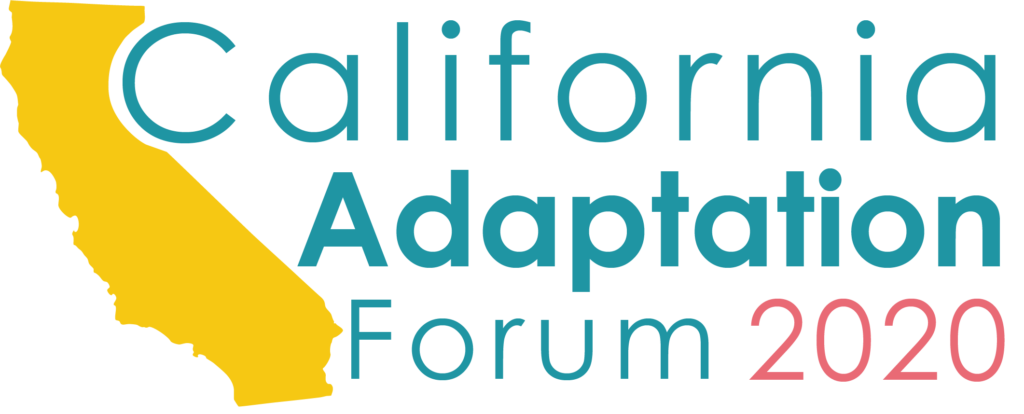Last year’s California Adaptation Forum was one of the first events I attended in my new role as the Coordinator of the Resilient Communities Initiative (RCI). Since I was new to the scene, I spent my first CAF listening, networking, and learning from the adaptation and equity professionals who would be my colleagues going forward.
At one point during the conference, one of the speakers made a casual joke about the end of the world. Nervous laughter erupted from the audience. At the time I found it odd to see so many people laugh at the real prospect of their own demise. But as my job has progressed, I’ve experienced this strange joking laughter many times in the adaptation community. At this point, I recognize it for what it is: the first stages of shock.
In the past few years, language in the field of climate justice and adaptation planning has shifted from discussions of mitigation, to adaptation, to resilience. These are classic buzzwords thrown around by the adaptation community were created in academia, adopted by foundations and disseminated to the public and non-profit sector.
Put colloquially, mitigation means this: we have a problem, we think we can prevent it, and we are putting our energy towards solutions. Adaptation means: we have a problem, we aren’t sure if we can solve it, so we might have to adapt. Resilience means something much more dire. Resilience is the ability to return to a normal state after a disaster or disruption. It means, we have a problem, a solution is unlikely to be forthcoming and even if it does come, we are going to bear a lot of damage before we get there.
Hidden in this complicated language is a simple truth: many of the adaptation professionals have moved on to a framework of crisis management and essentially have given up hope of solving the problem of climate change. We are assuming that the war is already lost, even as the fight for survival continues.
We now understand that inequality is driving climate change, yet fear to take on those at the top. Last week an article appeared on CNBC outlining a conversation by a private consultant talking to members of the 1% about how to prepare for “the event.” The event cynically refers to the point where the effects of climate change are so severe as to render our political and economic systems immobile. The consultant relays several scenarios posited by the wealthy as to how to survive the ensuing chaos. Every possibility in the book was put forward except the one thing that could actually help: give away your money now.
According to the New Yorker, nearly half of all Silicon Valley Billionaires have invested in “apocalypse insurance” in the form of bunkers, vacation houses, and various stockpiled materials. Fewer have invested in Disadvantaged Communities. Last summer members of the RCI sat down with youth from the Growing Justice Youth Program at Rooted in Resilience, to develop communications messages for a climate justice campaign aimed at this demographic. They came up with, “Your money will not save you.” It’s a simple statement, but one that I find timely and apt.
We suffer from a crisis of imagination. The climate crisis has been spurred by a linear capitalist system that allows a few to make decisions for the many and keeps us from moving towards solving the problem merely because we lack money. Moreover, those few who are allowed to make linear decisions about their industries fail to account for the end impact of their products, creating massive waste and our current climate disaster. We have been living our lives in a world of inequitable and extractive behaviors for so long that we cannot imagine another way. The rich simply can’t conceive any other answer than stockpiling, hoarding, and screwing over massive swaths of the population. But we must.
In the year and a half since I joined the RCI I’ve learned a lot of things. I’ve learned that the effects of sea level rise, or, as RCI member Sheridan Enamoto refers to it, “water level rise,” is already affecting Bay Area communities. I’ve learned that toxic chemicals left on our shorelines by irresponsible corporations and the US government threaten our communities further. This summer we are seeing record breaking temperatures (you might note that this link plays over a car commercial that says “Winning Over the World: Our Idea of Luxury.” I don’t even know what to say about this) and Antarctica is melting at a rate that seems cliche to call alarming. In light of all this, it seems natural to be scared and prepare for the worst.
I’ve also learned that the solutions to our crisis are there and readily available. This world was meant to be regenerative, meaning that given a certain equilibrium, the planet can restore itself. Our planet has fallen out of equilibrium, but we have the resources to put it back.
Every day new technologies are being invented that can spur us to change. Right now there are folks looking at ways we can use bioremediation to clean up toxic sites around the world. Alternative building materials based on regenerative materials are being created, such as the San Francisco corporation that is exploring innovative ways we make building material from mushrooms. Hemp concrete has been developed that is actually carbon negative, meaning our buildings can be built with smaller, and in some cases greenhouse-positive, carbon impacts. Folks are exploring the ability of carbon scrubbers to help us take carbon out of the atmosphere.
Even better than the new technologies, the ways in which traditional systems of land management can be used to help us manage climate change. Composting is being touted for its ability to renew previously believed unusable land. Restoring watersheds and marshlands are being explored as a way to combat sea level rise. Planting trees, which helps sequester carbon while cleaning the air we breathe, is easy and readily available to all.
It’s time to move beyond the scarcity framework that sees this problem as difficult to solve. The pathway is actually quite simple. All we have to do is convince the wealthy 1% to give away 90% of their wealth to disadvantaged communities. While this sounds radical, it actually isn’t. All of these people will still be rich and comfortable and we can solve the world’s problems.
We can use some of these funds to invest in local governments to pay people to be a part of the climate resiliency planning processes. We can fund grassroots organizations that have been working in communities to help bring community members into the political and planning process for decades on shoestring or nonexistent budgets. We can create green business incubator programs and invest in local businesses to rebuild a regenerative economy from the ground up, empowering the disadvantaged to become the decision makers and revenue generators in their own communities.
All the innovation and technology in the world means nothing if we cannot get it into the hands of the communities most vulnerable to climate change and use it to empower them to create regenerative lives for themselves. Preparing millions of people for the effects of resource scarcity, climate disasters, and resulting in forced migration, will take a huge investment of time and human capital. While we do that we must also get them imagining a solution and moving beyond resilience to actually reverse climate change. We must move on from a framework of survival and imagine ourselves thriving in a new regenerative paradigm. I’m proud to be a part of a coalition of social justice organizations that are rising to the call to action.
The Resilient Communities Initiative (RCI) is an intersectional, intergenerational, interracial coalition led by the communities most impacted by the combined forces of economic underdevelopment, environmental injustice, and institutionalized racism. We stand firmly in the belief that the only way to face down the impending climate challenges headed our way is to lead with the communities that are the most impacted by environmental injustices and most vulnerable to climate disaster.
The RCI collectively has hundreds of years of experience in the environmental justice field. Many of the members defined the word equity through the work that they have done throughout the years. And yet, funding for the grassroots organizations that have carried the torch for the EJ movement is scarce. As we find the need for these voices to be elevated at it’s most dire, we find the funding for that work to be the most under-resourced.
We cannot afford to sit by and laugh at the prospect of our demise. We must move beyond shock to action, and find a way to reverse climate change and lead our world back to its natural, regenerative state. The RCI is partnering with grassroots organizations, government agencies, and funders in the Bay Area to formulate a plan to do just that.
This year at the California Adaptation Forum, we partner with the San Francisco Foundation’s Great Communities Collaborative to host a forum to discuss these issues and have a conversation about what a real community response to climate change led by the most disadvantaged communities might look like and how we can turn that plan into action. We have to move beyond the feeling of shock and loss of hope. We have to move beyond conversations of resilience to regeneration. It’s time to make a plan. We hope that you will join us.

Phoenix Love Armenta is the Coordinator for the Resilient Communities Initiative, a coalition of Bay Area social justice organizations creating a plan for climate resiliency led by those most vulnerable to climate change. She has worked on environmental, racial, and social justice campaigns around the world, including anti-nuclear organizing in Japan and India, homeless advocacy in San Francisco, and multiple civic engagement and political campaigns throughout the Bay Area.

